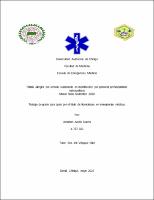| dc.contributor.author | Guerra, Jonathan Araón | |
| dc.date.accessioned | 2023-08-22T19:53:47Z | |
| dc.date.available | 2023-08-22T19:53:47Z | |
| dc.date.issued | 2020 | |
| dc.identifier.uri | http://jadimike.unachi.ac.pa/handle/123456789/862 | |
| dc.description.abstract | Allergic rhinitis has become a common disease worldwide, especially in people exposed
to substances or particles that sensitize patients. The main objective of the study, to evaluate the
prevalence of allergic rhinitis with the use of quaternary ammonium in cleaning and disinfection
per suspected or confirmed patient COVID -19 March to November 2020. The research was carried
out through surveys, where two questionnaires, these formed a total of 50 items.
A retrospective descriptive study and the sample corresponded to the universe of study, a total of
110 people from 911. The main results in negative trend were: that 79 (71.8%) do not suffer from
allergic rhinitis, 29 (26.3%) suffer from this condition and 2 (1.9%) do not know it. Among the
79 people who do not suffer from allergic rhinitis, 38 (48.1%) are exposed to quaternary
ammonium and the difference is 40 (50.6%) and 1 (1.3%) is unknown. Of the people who suffer
from allergic rhinitis, 29, 17 (58.6%) are not exposed to quaternary ammonium and only 12
(41.4%) if they are exposed, which shows that there is a low number of respondents who have
manifested allergy to quaternary ammonium. Allergic rhinitis in cleaning and disinfection, after
evaluating the 911 personnel, can be classified as acceptable, since the majority of the answers
were negative. The results of the graphs verify the low prevalence of quaternary ammonium
allergic rhinitis and do not verify the proposed research hypothesis that indicates, the prevalence
of allergy rhinitis increases with the use of quaternary ammonium in cleaning and disinfection.
Which will be used to expand knowledge to staff about allergic rhinitis and its relationship with
quaternary ammonium. | es_ES |
| dc.description.abstract | La Rinitis alérgica, se ha convertido en una enfermedad común a nivel mundial,
especialmente en personas expuestas a sustancias o partículas que sensibilizan a los pacientes. El
objetivo principal del estudio es evaluar la prevalencia de la rinitis alérgica con el uso del amonio
cuaternario en limpieza y desinfección por paciente sospechoso o confirmado covid-19 marzo
hasta noviembre 2020. Estudio tipo descriptivo retrospectivo y la muestra correspondió al
universo de estudio, un total de 110 personas del 911. La investigación se realizó a través de
encuestas, en donde se utilizaron dos cuestionarios, estos formaron un total 50 ítems.
Los principales resultados en tendencia negativa fueron: que 79 (71.8%) no padecen
rinitis alérgica, 29 (26.3%) padecen de esta afección y 2 (1.9%) lo desconoce. Dentro de las 79
personas que no padecen rinitis alérgica, 38 (48.1%) se encuentran expuestos al amonio
cuaternario y la diferencia 40 (50.6%) y 1 (1.3%) lo desconoce. De las personas que padecen
rinitis alérgica 29, 17 (58.6%) no están expuestos al amonio cuaternario y solamente 12 (41.4%)
sí están expuestos, lo que evidencia que existe una baja cantidad de encuestados que han
manifestado alergia al amonio cuaternario. La rinitis alérgica en la limpieza y desinfección, tras
la evaluación realizada al personal del 911, se puede calificar como aceptable, ya que la mayoría
de las respuestas fueron negativas. Los resultados de las gráficas comprueban la baja prevalencia
de rinitis alérgica por amonio cuaternario y no comprueba la hipótesis de investigación propuesta
que señala, la prevalencia de la rinitis alérgica aumenta con el uso del amonio cuaternario en
limpieza y desinfección. Lo cual se ultilizará para ampliar conocimientos al personal sobre la
rinitis alérgicas y su relación con el amonio cuaternario. | |
| dc.language.iso | es | es_ES |
| dc.publisher | Universidad Autónoma de Chiriquí | es_ES |
| dc.subject | ALERGIAS | es_ES |
| dc.subject | RINITIS | es_ES |
| dc.title | Rinitis .alérgica por amonio cuaternario en desinfección por personal prehospitalario metropolitano Marzo hasta noviembre 2020 | es_ES |
| dc.type | Thesis | es_ES |

